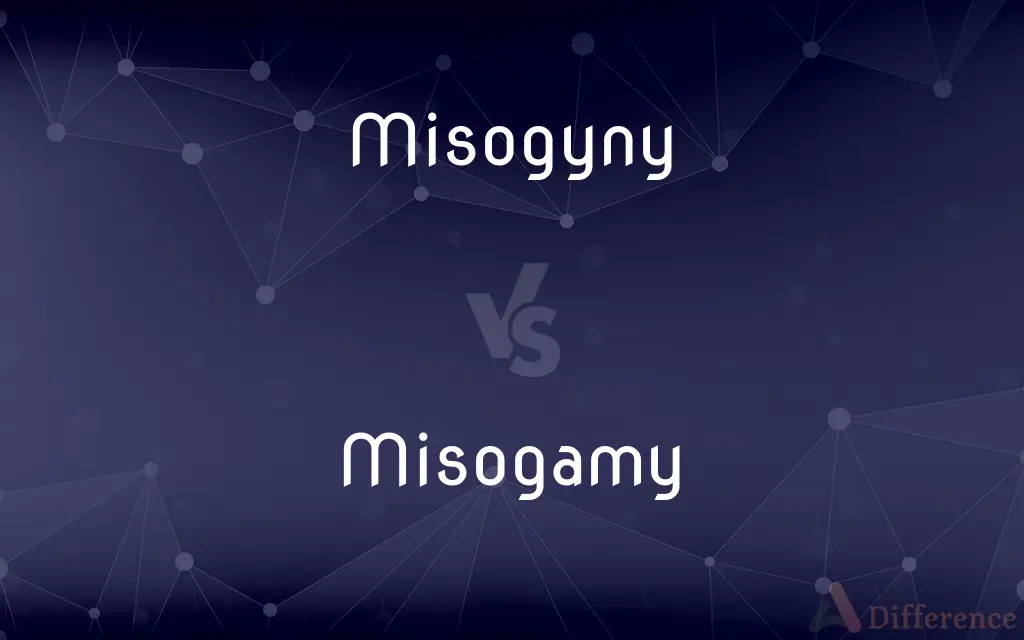Misogyny vs. Misogamy — What's the Difference?
By Maham Liaqat & Fiza Rafique — Updated on April 6, 2024
Misogyny is the dislike of, contempt for, or ingrained prejudice against women, while misogamy refers to the hatred of marriage, showcasing distinct focuses.

Difference Between Misogyny and Misogamy
Table of Contents
ADVERTISEMENT
Key Differences
Misogyny manifests as a deep-seated prejudice against women, often resulting in discrimination, violence, and the perpetuation of gender inequalities. On the other hand, misogamy is an aversion to marriage, not specifically targeted at a particular gender but at the institution of marriage itself.
While misogyny can be observed in various aspects of society including workplaces, media, and legal systems, where it impacts the opportunities and rights of women, misogamy may stem from personal beliefs, bad experiences, or cultural criticisms of the marital system. Whereas misogyny often leads to tangible harm and systemic challenges for women, misogamy primarily affects personal relationships and societal perceptions of marriage.
The roots of misogyny are often traced to historical, cultural, and institutional biases that have marginalized women over centuries. In contrast, misogamy might arise from modern skepticism towards traditional institutions, personal trauma, or philosophical beliefs about personal freedom and autonomy.
Campaigns and movements against misogyny seek to address and dismantle gender biases, advocating for equal rights, respect, and opportunities for women. Conversely, discussions around misogamy tend to focus on the evolving nature of personal relationships and the legal institution of marriage, questioning its relevance and fairness in contemporary society.
Misogyny has a broad impact on the societal and individual level, influencing legislation, workplace dynamics, and interpersonal relationships, perpetuating gender disparities. Misogamy, while less pervasive in its societal impact, reflects changing attitudes towards marriage, highlighting concerns about personal liberty, divorce rates, and the legal ramifications of marriage.
ADVERTISEMENT
Comparison Chart
Definition
Dislike of, contempt for, or ingrained prejudice against women.
Hatred or dislike of marriage.
Target
Specifically directed at women.
Directed at the institution of marriage, regardless of gender.
Manifestation
Discrimination, violence, and gender inequalities.
Personal beliefs, cultural criticisms, and bad experiences.
Roots
Historical, cultural, and institutional biases.
Modern skepticism, personal trauma, philosophical beliefs.
Social Impact
Affects opportunities, rights of women, and societal norms.
Affects personal relationships and perceptions of marriage.
Compare with Definitions
Misogyny
Hatred of women manifesting in various societal layers.
Misogyny in media often goes unnoticed but has a lasting impact.
Misogamy
Personal choice against marriage due to philosophical reasons.
Her misogamy is more about valuing independence than disliking partnerships.
Misogyny
Prejudice against women.
The company's culture of misogyny discouraged women from applying.
Misogamy
Criticism of the marital institution.
Misogamy is fueled by debates on the legal implications of marriage.
Misogyny
Violence targeted at women due to their gender.
The rise in gender-based violence is a direct result of misogyny.
Misogamy
Dislike or hatred of marriage.
His misogamy stems from observing multiple failed marriages in his family.
Misogyny
Discriminatory practices against women.
Wage disparity is a clear sign of misogyny in the workplace.
Misogamy
Aversion to the concept of marrying.
Modern relationships often reflect a growing trend of misogamy.
Misogyny
Systemic inequality favoring men over women.
Misogyny is evident in the underrepresentation of women in leadership roles.
Misogamy
Cultural shift towards questioning marriage.
The increase in cohabitation may be indicative of widespread misogamy.
Misogyny
Misogyny () is hatred or contempt for women or girls. It is a way of keeping women at a lower status than men.
Misogamy
Misogamy is an aversion to or hatred of marriage. The word dates from the mid-17th century and combines the Greek misos (hatred) with gamos (marriage).
Misogyny
Dislike of, contempt for, or ingrained prejudice against women
She felt she was struggling against thinly disguised misogyny
Misogamy
Hatred of marriage.
Misogyny
Hatred or mistrust of women.
Misogamy
Hatred of or opposition to marriage
Misogyny
Hatred of, contempt for, or prejudice against women.
Misogamy
Hatred of marriage.
Misogyny
Hatred of women. Contrast misandry.
Misogamy
Hatred of marriage
Misogyny
Hatred of women
Common Curiosities
Does misogamy affect only certain age groups?
No, misogamy can be found across various age groups, often influenced by personal experiences or cultural trends.
How can societies combat misogyny?
Through education, legal reforms, gender equality initiatives, and cultural shifts that challenge gender biases.
Can literature and media help reduce misogyny?
Yes, by promoting gender equality and challenging stereotypes, literature and media can play a significant role in reducing misogyny.
Can someone be misogynistic and misogamistic at the same time?
Yes, it's possible, but these attitudes stem from different prejudices – one against women, the other against marriage.
How does misogyny manifest in online spaces?
Through harassment, trolling, and the spread of misogynistic content, impacting women's participation in digital platforms.
How do personal experiences contribute to misogamy?
Negative personal experiences with relationships or observing failed marriages can lead to a distrust or dislike of the institution.
Is misogamy a personal choice or a societal issue?
It can be both; personal experiences can lead to misogamy, but it can also reflect broader societal questions about the value of marriage.
Are there positive aspects of misogamy?
Some may argue that misogamy encourages individuals to question traditional norms and consider alternative forms of relationships.
Can marriage still be relevant in a society with prevalent misogamy?
Yes, marriage can evolve and remain relevant if it adapts to changing societal values and expectations.
Can education combat both misogyny and misogamy?
Yes, education that promotes gender equality and critical thinking about societal institutions can address both issues.
What role do cultural norms play in perpetuating misogyny and misogamy?
Cultural norms can reinforce gender stereotypes and traditional views on marriage, contributing to both misogyny and misogamy.
How does misogyny affect mental health?
It can lead to anxiety, depression, and low self-esteem among women, affecting their overall well-being.
Does the rise of feminism correlate with an increase in misogamy?
Not necessarily; while feminism challenges traditional gender roles, it doesn't inherently advocate for or against marriage.
Is it possible to change a misogynistic or misogamistic mindset?
Yes, through education, open dialogue, and exposure to different perspectives, it's possible to change these mindsets.
What legal measures can be taken against misogyny?
Implementing stricter laws against gender-based violence and discrimination, and ensuring equal rights and opportunities.
Share Your Discovery

Previous Comparison
Finesse vs. Panache
Next Comparison
Envy vs. HateAuthor Spotlight
Written by
Maham LiaqatCo-written by
Fiza RafiqueFiza Rafique is a skilled content writer at AskDifference.com, where she meticulously refines and enhances written pieces. Drawing from her vast editorial expertise, Fiza ensures clarity, accuracy, and precision in every article. Passionate about language, she continually seeks to elevate the quality of content for readers worldwide.














































